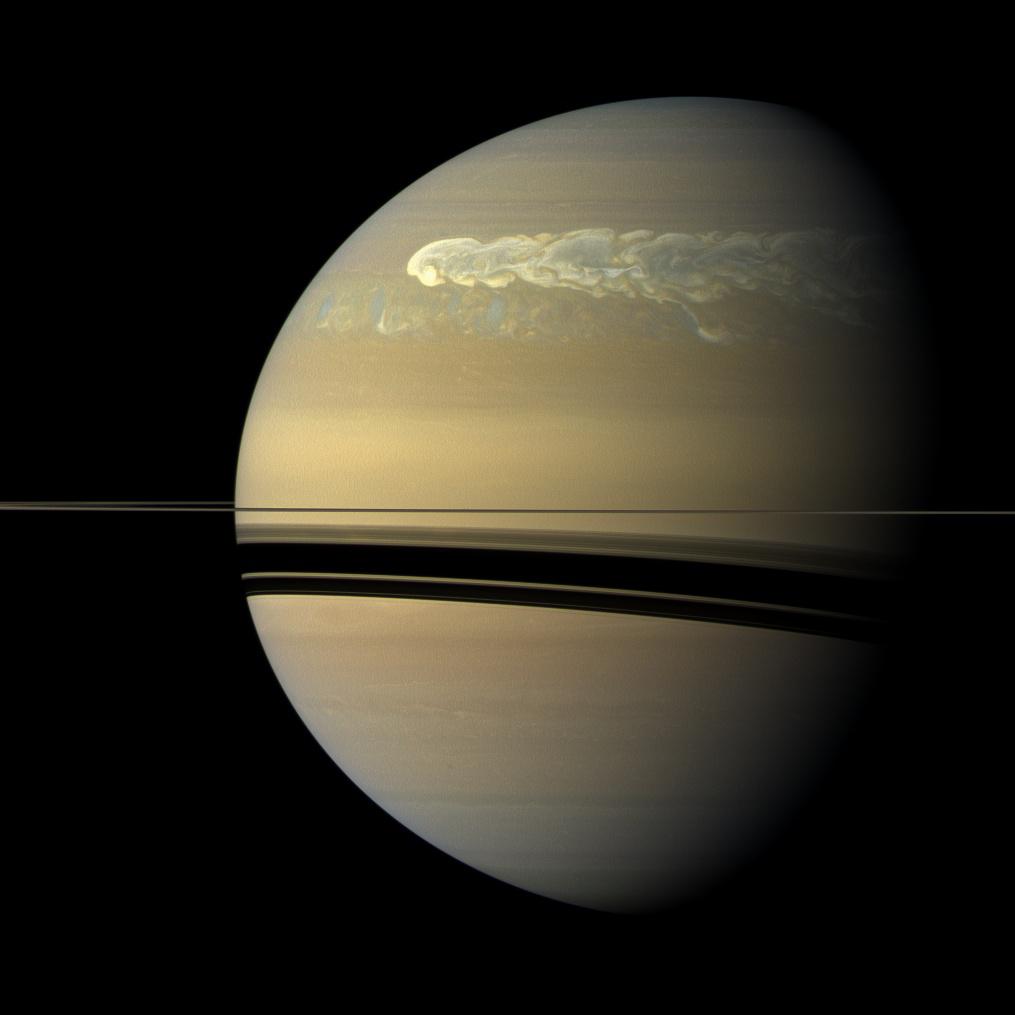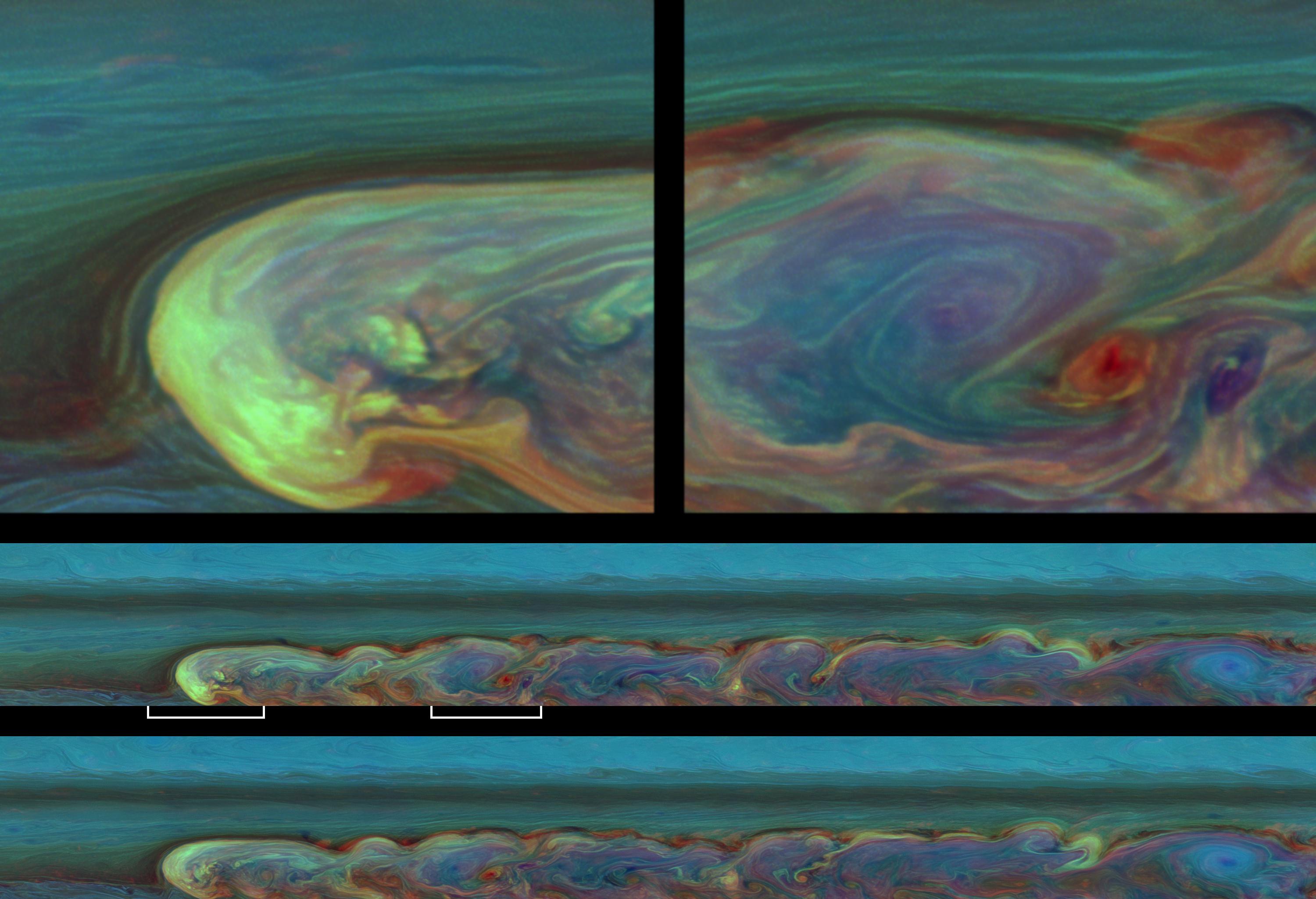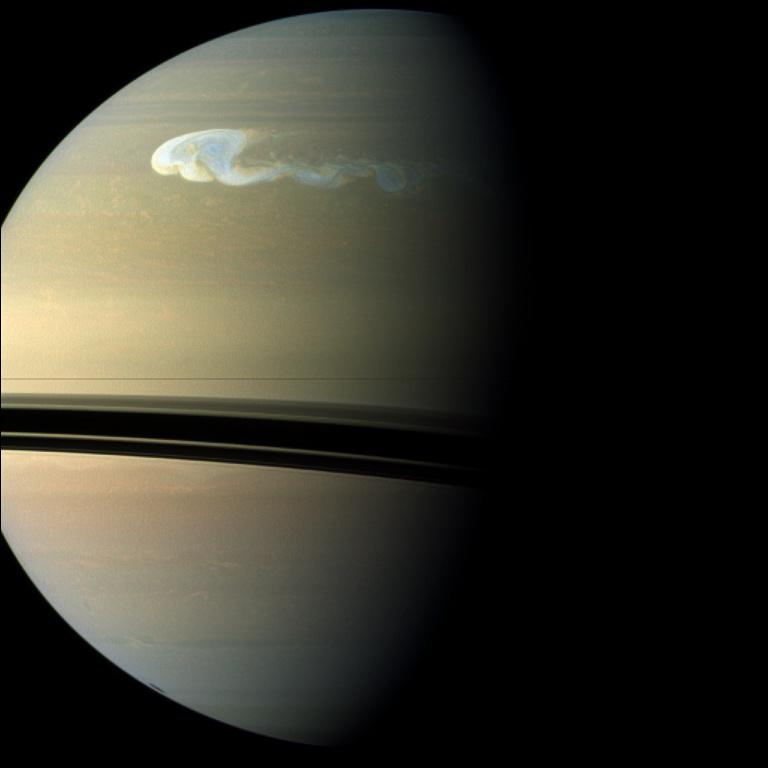NASA JPL-Caltech Cassini | 2011 May 19
Looking Deep into a Huge Storm on SaturnNASA's Cassini spacecraft and a European Southern Observatory ground-based telescope tracked the growth of a giant early-spring storm in Saturn's northern hemisphere that is so powerful it stretches around the entire planet. The rare storm has been wreaking havoc for months and shooting plumes of gas high into the planet's atmosphere.
Cassini's radio and plasma wave science instrument first detected the large disturbance, and amateur astronomers tracked its emergence in December 2010. As it rapidly expanded, its core developed into a giant, powerful thunderstorm. The storm produced a 3,000-mile-wide (5,000-kilometer-wide) dark vortex, possibly similar to Jupiter's Great Red Spot, within the turbulent atmosphere.
The dramatic effects of the deep plumes disturbed areas high up in Saturn's usually stable stratosphere, generating regions of warm air that shone like bright "beacons" in the infrared. Details are published in this week's edition of Science Magazine.
"Nothing on Earth comes close to this powerful storm," says Leigh Fletcher, the study's lead author and a Cassini team scientist at the University of Oxford in the United Kingdom. "A storm like this is rare. This is only the sixth one to be recorded since 1876, and the last was way back in 1990."
This is the first major storm on Saturn observed by an orbiting spacecraft and studied at thermal infrared wavelengths, where Saturn's heat energy reveals atmospheric temperatures, winds and composition within the disturbance.
Temperature data were provided by the Very Large Telescope (VLT) on Cerro Paranal in Chile and Cassini's composite infrared spectrometer (CIRS), operated by NASA's Goddard Space Flight Center in Greenbelt, Md.
"Our new observations show that the storm had a major effect on the atmosphere, transporting energy and material over great distances, modifying the atmospheric winds -- creating meandering jet streams and forming giant vortices -- and disrupting Saturn's slow seasonal evolution," said Glenn Orton, a paper co-author, based at NASA's Jet Propulsion Laboratory in Pasadena, Calif.
The violence of the storm -- the strongest disturbances ever detected in Saturn's stratosphere -- took researchers by surprise. What started as an ordinary disturbance deep in Saturn's atmosphere punched through the planet's serene cloud cover to roil the high layer known as the stratosphere.
"On Earth, the lower stratosphere is where commercial airplanes generally fly to avoid storms which can cause turbulence," says Brigette Hesman, a scientist at the University of Maryland in College Park who works on the CIRS team at Goddard and is the second author on the paper. "If you were flying in an airplane on Saturn, this storm would reach so high up, it would probably be impossible to avoid it."
Other indications of the storm's strength are the changes in the composition of the atmosphere brought on by the mixing of air from different layers. CIRS found evidence of such changes by looking at the amounts of acetylene and phosphine, both considered to be tracers of atmospheric motion. A separate analysis using Cassini's visual and infrared mapping spectrometer, led by Kevin Baines of JPL, confirmed the storm is very violent, dredging up larger atmospheric particles and churning up ammonia from deep in the atmosphere in volumes several times larger than previous storms. Other Cassini scientists are studying the evolving storm, and a more extensive picture will emerge soon.
Monster Storm Rearranges Saturn Before Our EyesESO VLT | 2011 May 19ESO’s Very Large Telescope (VLT) has teamed up with NASA’s Cassini spacecraft to study a rare storm in the atmosphere of the planet Saturn in more detail than has ever been possible before. The new study by an international team will appear this week in the journal Science.
The atmosphere of the planet Saturn normally appears placid and calm. But about once per Saturn year (about thirty Earth years), as spring comes to the northern hemisphere of the giant planet, something stirs deep below the clouds that leads to a dramatic planet-wide disturbance (eso9014).
The latest such storm was first detected by the radio and plasma wave science instrument on NASA’s Cassini spacecraft, in orbit around the planet, and also tracked by amateur astronomers in December 2010. It has now been studied in detail using the VISIR infrared camera on ESO’s Very Large Telescope (VLT) in conjunction with observations from the CIRS instrument on Cassini.
This is only the sixth of these huge storms to be spotted since 1876. It is the first ever to be studied in the thermal infrared — to see the variations of temperature within a Saturnian storm — and the first ever to be observed by an orbiting spacecraft.
“This disturbance in the northern hemisphere of Saturn has created a gigantic, violent and complex eruption of bright cloud material, which has spread to encircle the entire planet,” explains Leigh Fletcher (University of Oxford, UK), lead author of the new study. “Having both the VLT and Cassini investigating this storm at the same time gives us a great chance to put the Cassini observations into context. Previous studies of these storms have only been able to use reflected sunlight, but now, by observing thermal infrared light for the first time, we can reveal hidden regions of the atmosphere and measure the really substantial changes in temperatures and winds associated with this event.”
The storm may have originated deep down in the water clouds where a phenomenon similar to a thunderstorm drove the creation of a giant convective plume: just as hot air rises in a heated room, this mass of gas headed upwards and punched through Saturn’s usually serene upper atmosphere. These huge disturbances interact with the circulating winds moving east and west and cause dramatic temperature changes high up in the atmosphere.
“Our new observations show that the storm had a major effect on the atmosphere, transporting energy and material over great distances, modifying the atmospheric winds — creating meandering jet streams and forming giant vortices — and disrupting Saturn’s slow seasonal evolution,” adds Glenn Orton (Jet Propulsion Laboratory, Pasadena, USA), another member of the team.
Some of the unexpected features seen in the new imaging from VISIR have been named stratospheric beacons. These are very strong temperature changes high in the Saturnian stratosphere, 250-300 km above the cloud tops of the lower atmosphere, that show how far up into the atmosphere the effects of the storm extend. The temperature in Saturn’s stratosphere is normally around -130 degrees Celsius at this season but the beacons are measured to be 15-20 degrees Celsius warmer.
The beacons are completely invisible in reflected sunlight but can outshine the emission from the rest of the planet in the thermal infrared light detected by VISIR. They had never been detected before, so astronomers are not sure if they are common features in such storms.
“We were lucky to have an observing run scheduled for early in 2011, which ESO allowed us to bring forward so that we could observe the storm as soon as possible. It was another stroke of luck that Cassini’s CIRS instrument could also observe the storm at the same time, so we had imaging from VLT and spectroscopy of Cassini to compare,” concludes Leigh Fletcher. “We are continuing to observe this once-in-a-generation event.”
Space.com | 2011 May 19
Thermal Structure and Dynamics of Saturn’s Northern Springtime Disturbance - L Fletcher et al
- Science Express (online 19 May 2011) DOI: 10.1126/science.1204774




